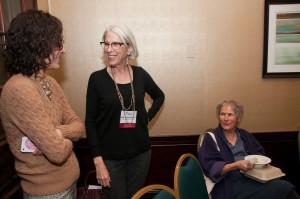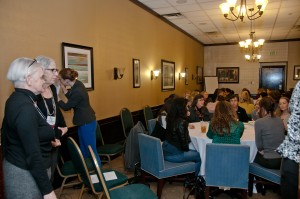By: Beth Alpert Nakhai, Ph.D.
Arizona Center for Judaic Studies
The University of Arizona

Dr. Beth Alpert Nakhai (center) at the Initiative on the Status of Women Lunch at theASOR Annual Meeting.
The last several decades have been ones of introspection for professional women, as they look to where they have been in their various vocations – and of activism, as they work to overcome discriminatory practices in the workplace. For archaeologists, three arenas, fieldwork, publication, and participation in professional societies, are all stepping-stones to academic advancement – and of course, promotion in the workplace is linked to success in each of these three arenas. I have been working for a number of years on projects, including this one, designed to document women’s participation in ASOR, its CAP (Committee on Archaeological Research and Publication)-affiliated excavations, and more.[1] Several years ago, then-ASOR President Tim Harrison asked me to chair a new Initiative on the Status of Women. Several members of the Initiative’s Steering Committee, Leann Pace and Jennie Ebeling, are currently engaged in studies of women’s inclusion in two ASOR journals, Bulletin of the American Schools of Oriental Research and Near Eastern Archaeology. Further reports on these and other projects will be made in theannual meeting in San Diego, in a workshop entitled Women at Work: Making One’s Way in the Field of Near Eastern Studies.
The focus of this short piece is the inclusion of women on ASOR’s Board of Trustees. For those of us working in the Middle East, ASOR is the premier professional society with which we associate. Therefore, to some extent, the ways in which women have been able to serve ASOR in leadership positions not only reflects but also furthers the positions of women working in Near Eastern studies. To collect the data for this study, I used the lists of trustees, officers, executives and other high-level leaders published in each volume of The Bulletin of the American Schools of Oriental Research (BASOR), from volume 1 (published) to volume 370 (published). Some highlights follow:
-

Current ASOR President, Dr. Susan Ackerman (left bottom corner) and Dr. Beth Alpert Nakhai at the Initiative on the Status of Women Lunch at theASOR Annual Meeting.
The American Schools of Oriental Research was founded in 1900. Its first female president, Susan Ackerman, began her term of service on 1 January. By comparison, the Archaeological Institute of America elected its first female president in 1965 (Margaret Thompson), and the Society of Biblical Literature elected its first female president in 1987 (Elisabeth Schuessler Fiorenza).
- Between 1919 and 1934, only one woman served ASOR in a leadership capacity. Mary Inda Hussey was an Assyriologist who received her Ph.D. from Bryn Mawr College, and was the first woman to study Semitic languages at the University of Leipzig. She was also one of the first women to be admitted to the American Oriental Society. Hussey taught at Mt. Holyoke College from 1913 to 1941. Harvard University published her two-volume Sumerian Tablets in the Harvard Semitic Museum. In addition, she was the author of a number of articles published in various professional journals. After her retirement, she published a volume of Akkadian religious texts from the Yale Babylonian Collection. Hussey spent 1931-1932 as the Annual Professor of the American School (now the William F. Albright Institute of Archaeological Research) in Jerusalem. She was the first woman to teach at the American School, and no other woman held a fellowship there for the next 30 years. During her Jerusalem year, Hussey traveled extensively throughout the Middle East and published her travelogue in BASOR in 1933.[2] Hussey died in 1952 and her obituary, written by F. S. Stephens, was published that year in BASOR (127: 3-4).[3]
– In what capacity was Hussey, an accomplished scholar and pioneering woman, permitted to contribute her valuable expertise and her precious time to ASOR? From 1917 to 1933, she was the “field secretary,” a position that involved handling BASOR subscriptions and working with the Fund for Biblical and Oriental Archaeological Research. Throughout this period of time, some twenty to thirty men served every year as ASOR trustees, executives, and more.
- The next woman in a leadership position within ASOR was Lucetta Mowry of Wellesley College (associate trustee; 1958-59). From the early 1970s until the position was eliminated in 1991, other women also served as associate trustees. The first were Anne Kilmer of University of California, Berkeley; Edith Porado of Columbia University; and, Helene Kantor of the Oriental Institute, University of Chicago.
- The first woman to serve as an ASOR trustee was Joy Ungerleider (later Mayerson) of the Jewish Museum (1973-1974). The year also saw the first woman on an ASOR committee (Anne Kilmer on the Baghdad Committee). In the 1970s, several women served as associate trustees and committee members and in 1975, a second woman, Anne Cabot Ogilvy, became a Board trustee. In 1982-1983, about a quarter of ASOR’s trustees were women but not every subsequent Board contained this relatively high proportion of female trustees. At the start of the 21st century, male trustees outnumbered female trustees by approximately 3:1; in more recent years, more women have been elected to the Board and the proportion of men to women stands at approximately 2:1. TheBoard includes 21 male trustees and 10 female trustees.
- The first woman to serve as a Board officer was Anne Cabot Ogilvy (assistant treasurer, 1986-1988). Subsequent female officers include Kathryn Gould (assistant treasurer); Ingrid Wood (treasurer,); and, Lynn Dodd Swartz (secretary-present).
- The first woman to serve as a Board vice-president was Lydie Shufro (v-p for development, 1992-1993; v-p for public relations). She was followed by Martha Sharp Joukowsky ; Rachel Hallote; Tammi Schneider Ann Killebrew (development);Morag Kersel; Jennie Ebeling (membership); and, Sharon Herbert (present).
- The first (and only) woman to serve as Chair of the ASOR Board of Trusteeswas Elizabeth Moynihan (1985-1986).
- ASOR has never had a female executive director.
[1] I presented an earlier version of this paper, entitled On the Status of Women in the American Schools of Oriental Research, at theannual meeting of the American Schools of Oriental Research.
[2] “From Palestine to Mesopotamia: A Letter from Professor Hussey to Professor Barton.” BASOR 49 (1933): 19-22.
~~~
All content provided on this blog is for informational purposes only. The American Schools of Oriental Research (ASOR) makes no representations as to the accuracy or completeness of any information on this blog or found by following any link on this blog. ASOR will not be liable for any errors or omissions in this information. ASOR will not be liable for any losses, injuries, or damages from the display or use of this information. The opinions expressed by Bloggers and those providing comments are theirs alone, and do not reflect the opinions of ASOR or any employee thereof.